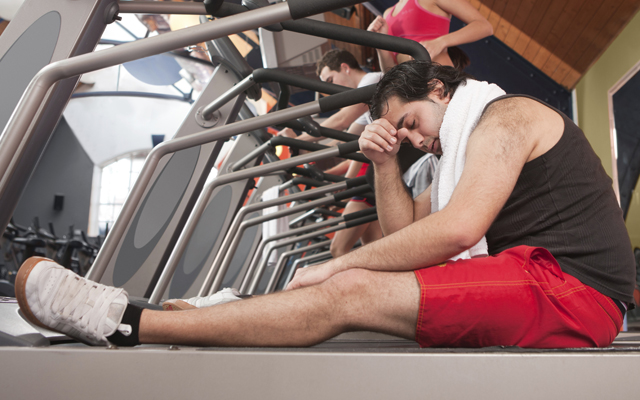Running is a great form of exercise, but too often gym-goers find themselves confined to the treadmill. Any exercise is beneficial, but there are established scientific benefits of getting outdoors and enjoying a run. The treadmill is simply not the same!
Here a few reasons why we think you should get outdoors:
1. Treadmills Can Alter Your Running Form.
Athletes train for marathons or triathlons on the treadmill and often find that when they compete, something is off. The reason might be that when running on a treadmill people take longer strides that alter their movement pattern (1). They spend more time in the air allowing more of the treadmill to pass underneath them (1). The problem is that this type of running is not quite the technique needed when running on ground.
There are also differences in acceleration on the treadmill versus the ground. For example, in a recent study investigating movement and acceleration of running, researchers found that when running over the ground you accelerate and can change your movement to accommodate the acceleration (2). On the treadmill, however, the ground literally accelerates and no movement adaptations to the accelerating belt can occur.
Altering running form can also directly translate into a greater chance of injuries. One study found that treadmill running caused the ankle to roll inward (called ankle eversion) more so than running over ground (3). Not only does treadmill running cause more eversion, but also greater peak eversion, eversion velocity, tibial internal rotation, and a greater tibial internal rotation velocity than over ground runners, all of which contribute to chronic injuries (4).
Bottom line: Running on the ground is better for technique.
2. Treadmills Don’t Properly Activate Posterior Muscle Groups.
When you run, you activate the powerful muscles in the rear of your body like the gluteal muscles and hamstrings. They contribute to hip extension, which is the movement in running that propels you forward over the ground. Running on the treadmill reduces hip extension in comparison to ground running. When combined with already underdeveloped gluteal muscles and hamstrings (from sitting, office work, and general sedentary living) this posterior area is neglected even further and predisposes the body to injury (2).
Bottom line: Running outside is better for your bottom.
3. Running Outside Is More Enjoyable.
One study found that when on treadmills, subjects ran considerably slower, reported higher rates of exertion, enjoyed themselves less, and experienced less satisfaction than runners who did their training outside. (5) The researchers of this study also found that subjects who ran on the treadmill had a higher perceived level of exertion even at lower speeds!
Exercise should never be viewed as dull or more difficult than it really is. Exercise needs to be enjoyable so you can keep doing it, otherwise it loses its value.
Bottom line: Running outside is more exciting and more fun than being inside trapped in the gym.
4. Running On Treadmills Burns Less Energy.
Running on a treadmill at the same speed requires less energy expenditure than running at the same speed outside. (6) A comparative analysis suggests that this difference may have to do with changes in the range of motion where legs have to do less work supporting the body (6). Bottom line: You’ll burn more calories (with less perceived effort) by running outside.
What Happens If You Must Use A Treadmill? How Can You Partially Overcome The Above issues?
Here are our tips:
- Set the treadmill on a slight incline to replicate ground running. Just a one percent increase in incline can make treadmill running on par with ground running from an energy-cost standpoint (7).
- Cross-train. Don’t feel you need to be tied to the treadmill at all times when you’re in the gym. Use the Stairmaster, elliptical, or go for a swim.
- Try sprint intervals to increase energy output and reap the benefits of high intensity interval training. Read “Runners, make sure part of your cardio training is high intensity” for more information.
Treadmills can be helpful, and many athletes can still use them in their training, but they should be viewed as a tool. Very few top athletes use treadmills exclusively. For any endurance athlete, the majority of the training should be done the old-fashioned way, outside and on the ground.
References
- Hanley B, Mohan AK. Changes in gait during constant pace treadmill running. The Journal of Strength & Conditioning Research 2014;28:1219-25.
- Van Caekenberghe I, Segers V, Aerts P, Willems P, De Clercq D. Joint kinematics and kinetics of overground accelerated running versus running on an accelerated treadmill. Journal of The Royal Society Interface 2013;10:20130222.
- Sinclair J, Richards J, Taylor PJ, Edmundson CJ, Brooks D, Hobbs SJ. Three-dimensional kinematic comparison of treadmill and overground running. Sports Biomechanics 2013;12:272-82.
- Sinclair J, Taylor PJ. Tibiocalcaneal kinematics during treadmill and overground running. 2014.
- LaCaille RA, Masters KS, Heath EM. Effects of cognitive strategy and exercise setting on running performance, perceived exertion, affect, and satisfaction. Psychology of Sport and Exercise 2004;5:461-76.
- Frishberg BA. An analysis of overground and treadmill sprinting. Medicine and Science in Sports and Exercise 1982;15:478-85.
- Jones AM, Doust JH. A 1% treadmill grade most accurately reflects the energetic cost of outdoor running. Journal of Sports Sciences 1996;14:321-7.





